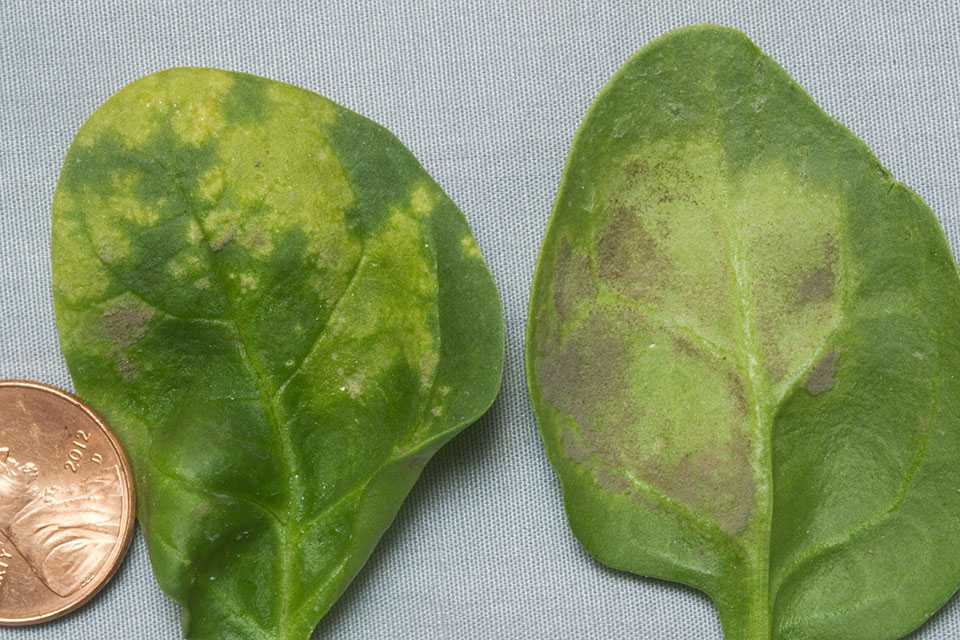New Pathogen Strains a Cause for Concern Among Vegetable Growers

The new, aggressive variant of the celery Fusarium yellows pathogen is causing disease on previously resistant celery plants.
Photo by Steven T. Koike
Parallels between the COVID-19 pandemic and diseases of crops continue to be evident. As we learn more about the coronavirus, at the same time we also are reminded about the nature of plant pathogens and the dynamics of how they infect and damage our crops.
One of the latest COVID-19 headlines has to do with strains of the virus. Throughout the world, the COVID-19 virus exists as several different genetic types or “strains” (also known as “variants”).
The pandemic initially starts in China with strain L of the virus. Strain S is the first detected variant, or mutated version, of COVID-19. Strain V follows. Presently, strains G, GR, and GH impact agriculture the most.
Recently, however, there is great concern about the new B.1.1.7 COVID variant, which apparently is much more efficient at infecting its human host and is more easily spread. First reported in the United Kingdom, this B.1.1.7 variant now has been detected in various parts of the world, including in the U.S.
Plant Disease Variants a Challenge
Plant pathogens also exist as different genetic types, which can be called “strains,” “variants,” “races,” and other designations. In some situations, the existence of different strains has little impact on crops, and farmers and other field professionals may not even be aware of these.
In other cases, however, the development of a new strain or race may signal a serious development in the field.
New strains or races can overcome the genetic resistance, bred into cultivars, that confers protection against the pathogen. In California, popular varieties of celery contained genes that made these varieties resistant to the Fusarium yellows pathogen. Growers can plant these cultivars into infested fields and still realize excellent yields.
The new race 4 of the Fusarium celery pathogen, however, overcomes these resistance genes, resulting in widespread losses.
Spinach always has been very susceptible to the downy mildew pathogen until breeders developed resistant varieties. Once breeders deploy resistant varieties , though, new races of the downy mildew develop and cause disease on previously resistant lines.
The gray mold pathogen, Botrytis, commonly develops variants that are tolerant to the various fungicides used to control it. Xanthomonas and Pseudomonas bacteria, Fusarium, rust, and other fungi are well known for their ability to change and develop new variants.
Why Are There Different Strains?
All microorganisms exist as a collection of closely related but diverse groups. In such populations, all the bacterial groups, or all the fungal groups, are not identical but vary slightly in their genetic makeups. This variation is caused by mutations, genetic recombination, and other factors.
Under certain biological or environmental situations, a particular, specific group can become prominent, reproduce at a greater rate, and emerge as a new pathogen variant that can cause disease on its hosts.

For several consecutive years, each time breeders developed a new resistant spinach cultivar, the downy mildew pathogen countered with yet another new race.
Photo by Steven T. Koike
How To Combat These Variants
Similar to the situation with the new B.1.1.7 COVID variant, diagnosis is the necessary first step. Through research, scientists must first develop detection techniques that confirm that a new downy mildew, Fusarium, or Xanthomonas variant is present and causing crop losses. Researchers use molecular analyses, inoculation experiments, and other research activities to document a new race or strain.
Following such documentation, researchers devise and standardize tests that diagnosticians and extension personnel can use to confirm if a crop disease outbreak is due to the new variant.
Next, it’s up to growers to manage the outbreak of a new plant pathogenic strain. Standard integrated pest management practices will repress most outbreaks.
- Practice crop rotation so that the susceptible crop is not over planted.
- Implement appropriate cultural practices to favor growth of the crop but impede pathogen development.
- Practice good sanitation measures so the new strain is not spread via infested soil (for soilborne pathogens), crop residues, or contaminated equipment.
- Alter fungicide strategies so that different modes of action are used against chemically tolerant variants.
Because many of the new plant pathology races have breached the genes that used to confer resistance, a key management component is the breeding of new cultivars that will be resistant to the new variants.
Such breeding is challenging work, takes time to achieve, and may have a relatively short-term benefit. Microorganisms are incredibly resilient and adaptable. Once a new resistant cultivar is in use, the pathogen population can counter and come up with yet another new variant, demonstrating that disease control can be a matter of continued back-and-forth escalation between microbes and humans.










